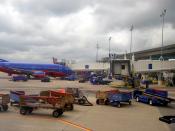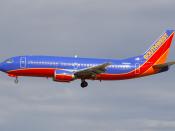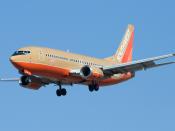"Southwest Airlines: In a Different World" Individual Report
Bernardo Lança Cirnes Nogueira de Oliveira nº 2382 Quality Management - 2014/2015
Southwest Airlines started as an intrastate operator in Texas with a budget
airline philosophy as it survived a severe price-war. It was the 7th largest country by
April 1993, and was expanded to become a national carrier, serving major cities in the
US.
The Southwest Airlines model was characterized by the use of non-
conventional models for low-cost, have Fun Together, treat employees as family, hire
people who form the fit and are involved in the activities and culture of the company,
and finally, control of the solid growth of the airline. It had come across some issues
and the one that most worried the heads of the company was the expansion. And
that's why despite the great success Southwest has maintained, the airline did face
several issues that played an important role to its continued profitability.
Based on a really conservative growth strategy, Southwest's major concern was
as said before expansion. And that's why the airline had faced a vital expansion
decision about where and how to put two new Boeings 737's into service. This decision
was comprised of some important components, as Southwest had to meet the daily
demand, find out enough facilities, keep the alignment and consistency of the strategy
and guarantee that the entrance in a new market is made in the right moment. But the
main problem related to these issues was finding the facilities that provided low cost
to the company and at the same time keeping the profit as high as possible. What the
company needed to take into account would have been new costs in terms of
construction in major city airports, the addition of two new gates and hiring new
people, which consequently, led to more labour costs. Competition in this type of
industry is tough and the risk of substitutes is really high. And in order to overcome
these threats, the company must maintain its competitive advantage and strategic
coherence when facing future expanding decisions, and that these decisions are in line
with its short-haul, high-frequency, low-cost and "LUV" strategies. Southwest did not
want to enter in a congested market with high costs, many delays and poor weather,
that's why they thought that the best strategy was keeping the operating costs low
and ensure promptness in the implementation of new routes.
"Southwest Airlines: In a Different World" Individual Report
Bernardo Lança Cirnes Nogueira de Oliveira nº 2382 Quality Management - 2014/2015
So in order to help solving the problems of expansion, the airline should
increase its market research. As written during the case, Southwest used to fly only to
smaller airports that are situated in less congested cities. However, this strategy was
implemented to reduce turnaround time (the ten minute turnaround), gate holds and
also in-air waiting, and so customers would be more rapidly served in terms of the
supply of flights, and the company would be more efficient (with less costs and more
profits). But more consumers started to complain that it was harder for them to get
into larger cities when they wanted to fly with this airline. As a result, Southwest ought
to expand its targeted market by purchasing more planes to fly into larger cities, as
well as making longer trips rather than just a one or two hour flight. This would mean
that they will need bigger planes, with more autonomy, like for example the new
Boeings 737.
Southwest Airlines strategy has been successfully implemented, and they
should continue in developing a cost leadership strategy to under price competitors
and gain market share, as well as continuing its focus strategy of providing frequent
"point-to-point" flights. The expansion into new cities should be at a moderate pace in
order to ensure adequate coverage of new markets, because the ideal new cities will
allow the company to have non-stop flights. Since the range of the aircrafts expands,
the potential markets will expand too.
In a different perspective, the company should also strengthen its mission
statement, as a low-price, frequent flight, short haul and reliable carrier, and continue
to hold new technologies such as ticketless travel and PC reservations. These new
technologies will allow Southwest to control costs, to enter in more markets, and also
maintain and reinforce its image of a safe and reliable carrier. Finally, the company
should continue cultivating and boosting its remarkable and unique culture: The
company's fun "LUVing" attitude and dedication to its employees. These have
contributed with both tangible and intangible benefits for the company, and are a truly
competitive advantage comparing to its competitors.


